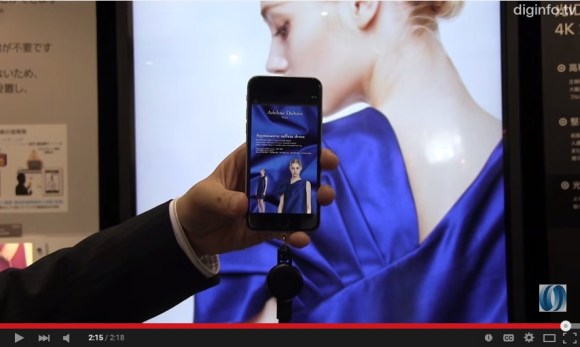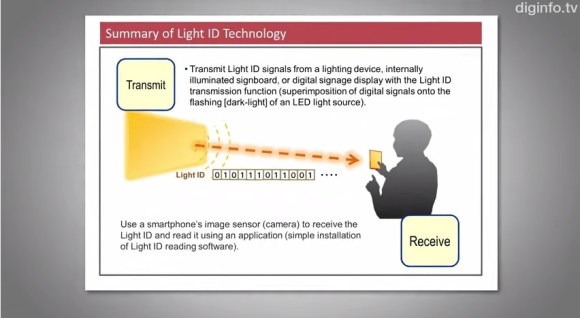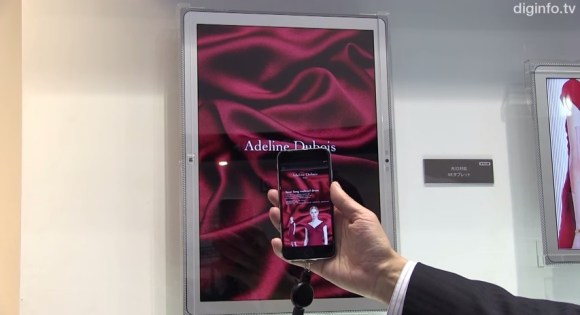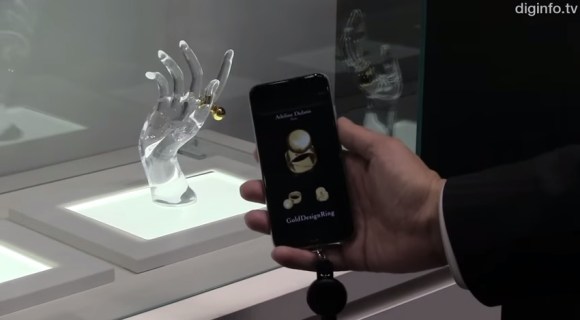
There are many ways that data is transferred these days, be it fiber optic cables, Wi-Fi, Bluetooth, 4G-LTE, and a whole slew of other brand names and acronyms the meanings of which I don’t care to learn.
Now Panasonic has come up with a way to send and receive data that’s easy for everyone to understand: light. Actually it uses light emitting diodes (LED) to be exact, but that’s about as technical as this explanation needs to get, I promise.
The news comes via DigInfo TV who interviewed a rep from Panasonic. Basically, the light of an LED can flicker on and off in a pattern that can be detected by a sensor such as your smartphone’s camera. It works kind of like Morse code but with light…and that’s it really.
You might be wondering why no one else has thought of this before given how simple it is. Actually lots of people have, but this technique had a lot of limitations for everyday use. The tricky part is in the timing of the flicker.
If you flick the light on and off incredibly fast, you can send lots of data quickly and the human eye would never notice it. However, a smartphone camera wouldn’t be able to notice it either and you’d have to get a separate specialized device which would be a drag.
The other way, you could slow down the flicker so that a smartphone could catch the code. But then your brain would be able to as well, and might lead to eye-irritating signs that would make city streets look like a scene from Captain Power.
▼ For the younger folk who might not know Captain Power. For those who do, get your guns ready!
What Panasonic did was find that sweet spot that is undetectable by the human eye but also just enough of a contrast for a smartphone to catch. One of their tricks was simply adjusting the brightness levels rather than turning the light completely on or off.
▼ Although the ad simply says “Adeline Dubois,” those interested can get more info delivered from the sign’s light to their smartphone.
Although very simple in design, the range of applications for this method is very wide. Of course, any LED illuminated signboard could be used to send product information instantly to your phone. For example, simply pointing your smartphone at a movie poster could start up a full trailer of it to help you decide if you want to watch it. This could also considerably free up space in advertising design needed to provide information.
Also for travelers in foreign lands, pointing your phone at an illuminated sign written in, say, Japanese could instantly transmit a translated version of it in your own language. The sign itself doesn’t even have to provide the light. For example, the ambient LED light of a restaurant could contain the data for versions of their menus in different languages or the nutritional information for each dish.
▼ The light illuminating the ring on display also transmits the name and maker of it to the smartphone.
If this system gets picked up by other companies and government then we could be looking a future that’s not exactly bright but slightly dimmer and flickering.
Source: DigInfo TV (English/Japanese)
Video: YouTube – DigInfo TV, ASISHIN




 LED plant factories offer efficient 3D alternative to traditional gardening
LED plant factories offer efficient 3D alternative to traditional gardening Musical Magic! From 2-Dimensional Notes to Real Music With the Swipe of a Scanner
Musical Magic! From 2-Dimensional Notes to Real Music With the Swipe of a Scanner A better use for your smartphone than Angry Birds: Remotely driving your car!
A better use for your smartphone than Angry Birds: Remotely driving your car! Japanese convenience store plans to increase shoppers’ phone data capacity just for visiting
Japanese convenience store plans to increase shoppers’ phone data capacity just for visiting Starbucks Japan asks customers to not use smartphones, laptops in its cafes for special eco event
Starbucks Japan asks customers to not use smartphones, laptops in its cafes for special eco event Mr. Sato accosts award-winning actor Hideaki Ito【Interview】
Mr. Sato accosts award-winning actor Hideaki Ito【Interview】 Hello Kitty Choco Egg figures are an adorable trip through three periods of Japanese pop culture【Pics】
Hello Kitty Choco Egg figures are an adorable trip through three periods of Japanese pop culture【Pics】 Tokyo cafe offers all-you-can-eat pancakes for less than ten bucks!
Tokyo cafe offers all-you-can-eat pancakes for less than ten bucks! Japan’s otoshidama tradition of giving kids money at New Year’s gets a social welfare upgrade
Japan’s otoshidama tradition of giving kids money at New Year’s gets a social welfare upgrade The results are in! One Piece World Top 100 characters chosen in global poll
The results are in! One Piece World Top 100 characters chosen in global poll Mr. Sato interviews: One-on-one with Japanese Santa
Mr. Sato interviews: One-on-one with Japanese Santa All-you-can-eat yakiniku in Shinjuku for less than 10 bucks!
All-you-can-eat yakiniku in Shinjuku for less than 10 bucks! Can Kyoto supermarket takeout let you enjoy the local cuisine without fancy restaurant prices?
Can Kyoto supermarket takeout let you enjoy the local cuisine without fancy restaurant prices? We try all-you-can-eat sushi for less than $8.50 at a restaurant in Tokyo’s Chiyoda Ward
We try all-you-can-eat sushi for less than $8.50 at a restaurant in Tokyo’s Chiyoda Ward Awesome time lapse video shows Vietnamese artist carving amazingly detailed wooden Goku statue
Awesome time lapse video shows Vietnamese artist carving amazingly detailed wooden Goku statue 7-Eleven Japan starts new temporary luggage storage service in over 300 branches
7-Eleven Japan starts new temporary luggage storage service in over 300 branches Disillusionment at Tsukiji’s tourist-target prices led us to a great ramen restaurant in Tokyo
Disillusionment at Tsukiji’s tourist-target prices led us to a great ramen restaurant in Tokyo Japan may add Japanese language proficiency, lifestyle classes to permanent foreign resident requirements
Japan may add Japanese language proficiency, lifestyle classes to permanent foreign resident requirements Starbucks Japan releases new zodiac chilled cup drink for 2026
Starbucks Japan releases new zodiac chilled cup drink for 2026 Lacquerware supplier to emperor of Japan and Pokémon team up for new tableware
Lacquerware supplier to emperor of Japan and Pokémon team up for new tableware Starbucks teams up with 166-year-old Kyoto doll maker for Year of the Horse decorations【Photos】
Starbucks teams up with 166-year-old Kyoto doll maker for Year of the Horse decorations【Photos】 Starbucks on a Shinkansen bullet train platform: 6 tips for using the automated store in Japan
Starbucks on a Shinkansen bullet train platform: 6 tips for using the automated store in Japan Is this the most relaxing Starbucks in Japan?
Is this the most relaxing Starbucks in Japan? Large amount of supposed human organs left in Osaka marketplace
Large amount of supposed human organs left in Osaka marketplace Tokyo’s Tsukiji sushi neighborhood asks tour groups to stay away for the rest of the month
Tokyo’s Tsukiji sushi neighborhood asks tour groups to stay away for the rest of the month Japan’s human washing machines will go on sale to general public, demos to be held in Tokyo
Japan’s human washing machines will go on sale to general public, demos to be held in Tokyo Japanese train company is letting fans buy its actual ticket gates for their homes
Japanese train company is letting fans buy its actual ticket gates for their homes Tokyo considering law requiring more trash cans following litter increase in heavily touristed area
Tokyo considering law requiring more trash cans following litter increase in heavily touristed area Nintendo’s Kirby now delivering orders at Kura Sushi restaurants, but not in Japan
Nintendo’s Kirby now delivering orders at Kura Sushi restaurants, but not in Japan Tokyo event lets you travel back in time, for free, to celebrate 100 years since Showa era start
Tokyo event lets you travel back in time, for free, to celebrate 100 years since Showa era start Sanrio theme park in Japan announces plans to expand into a Sanrio resort
Sanrio theme park in Japan announces plans to expand into a Sanrio resort Survey asks foreign tourists what bothered them in Japan, more than half gave same answer
Survey asks foreign tourists what bothered them in Japan, more than half gave same answer Japan’s deadliest food claims more victims, but why do people keep eating it for New Year’s?
Japan’s deadliest food claims more victims, but why do people keep eating it for New Year’s? We deeply regret going into this tunnel on our walk in the mountains of Japan
We deeply regret going into this tunnel on our walk in the mountains of Japan Studio Ghibli releases Kodama forest spirits from Princess Mononoke to light up your home
Studio Ghibli releases Kodama forest spirits from Princess Mononoke to light up your home Major Japanese hotel chain says reservations via overseas booking sites may not be valid
Major Japanese hotel chain says reservations via overseas booking sites may not be valid Put sesame oil in your coffee? Japanese maker says it’s the best way to start your day【Taste test】
Put sesame oil in your coffee? Japanese maker says it’s the best way to start your day【Taste test】 The top 10 annoying foreign tourist behaviors on trains, as chosen by Japanese people【Survey】
The top 10 annoying foreign tourist behaviors on trains, as chosen by Japanese people【Survey】 No more using real katana for tourism activities, Japan’s National Police Agency says
No more using real katana for tourism activities, Japan’s National Police Agency says Starbucks Japan reveals new sakura drinkware collection, inspired by evening cherry blossoms
Starbucks Japan reveals new sakura drinkware collection, inspired by evening cherry blossoms The End of Barcodes? Toshiba Unveils Register Scanners that Can See Rather than Scan
The End of Barcodes? Toshiba Unveils Register Scanners that Can See Rather than Scan Japanese city passes ordinance to limit smartphone use, applies to people outside the city too
Japanese city passes ordinance to limit smartphone use, applies to people outside the city too
Leave a Reply